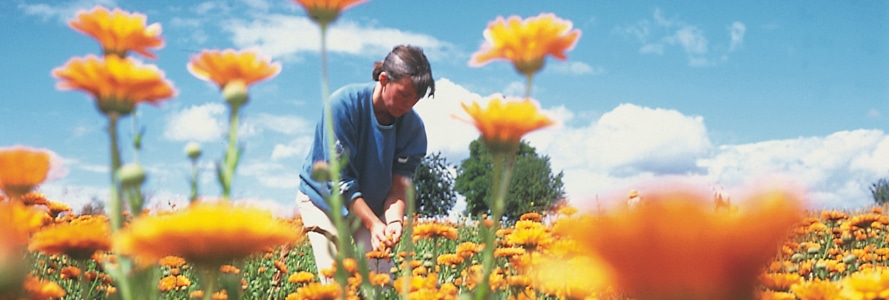How many 90-year-olds look as good as Weleda?
A health store staple that’s crossed over into spas, beauty boutiques and supermarkets without compromising its core ideals, the brand has built strong consumer loyalty and a burgeoning celebrity following.
To celebrate 90 years of sustainable beauty The Natural Beauty Yearbook flew over to Germany to find out more. This is what we discovered…
 Weleda trainer Andrea Strauss is standing in the middle of the company’s medicinal plant garden in Wetzgau, Germany, patiently explaining the roots of the company’s biodynamic philosophy to a group of Japanese visitors.
Weleda trainer Andrea Strauss is standing in the middle of the company’s medicinal plant garden in Wetzgau, Germany, patiently explaining the roots of the company’s biodynamic philosophy to a group of Japanese visitors.
As she talks, bees lazily buzz around the flowers behind her and the odd duck waddles across the path between plants. There are no tractors on site, just a handful of workers carefully tending the land.
The 60-acre garden may be only an hour’s bus ride from Stuttgart – but it’s light years away from conventional agriculture. Welcome to natural beauty, Weleda style.
Beauty basics
Weleda was founded over 90 years ago in Switzerland by scientist philosopher Rudolf Steiner and physician Ita Wegman. Today over 200 employees in 50 different countries help cultivate the 300 plant species that go into its range of natural beauty products.
As Strauss explains, Steiner’s philosophy wasn’t about discrediting science – but instead taking esoteric elements like planetary movements and human emotions into account when considering agriculture.
It’s about looking at the benefits of plants not just in a scientific way – but in a holistic way too,” she says.
At its heart, biodynamic agriculture – the method that Weleda uses to produce the most beneficial plants possible – is simply a system of ecological and sustainable farming. It sits alongside the core Weleda principles of fair trade, climate neutrality and the environmentally friendly processing of raw materials.
Giving something back
“The key is creating strong soil,” says Strauss.
“And to produce strong soil you must care properly for the land. For our crop we use green manure made up of different plants like clover and chamomile. Clover has small bacteria in its roots which capture nitrogen and makes the soil even richer.”
Strauss explains how it’s important to give something back to the land, “not just taking goodness out through harvest”. This means turning thirty per cent of the land over to wild flowers and plants to generate raw material for green manure and to improve biodiversity.
We never use pesticides. When you have a healthy soil it naturally protects against parasites – all except the snails. And to get rid of them we have the ducks, which love to eat them!”
 This central idea of closing the circle of production resonates throughout Weleda’s work. It’s there in the architecture around the botanical gardens and even represented in the company’s logo.
This central idea of closing the circle of production resonates throughout Weleda’s work. It’s there in the architecture around the botanical gardens and even represented in the company’s logo.
It’s also expressed in one of the three main techniques that are unique to biodynamic farming – horn manure.
“In Autumn we take a horn from a female cow and fill it with dung,” says Strauss.
“It’s then dug into the soil where it stays all winter. In spring we dig it out and inside is a powder, which we call ‘horn mist’”.
She moves over to what looks like a traditional well with a long wooden pole attached to the awning above. “Then we mix a small amount of powder with rain water and mix everything together for an hour to create a vortex.”
Strauss explains how every year plants rise from the soil, flower, and then return to the ground in their component parts.
“That’s the power of this preparation,” she says. “It has all the power and dynamism of the circle of life within it. It helps put everything in harmony.”
See Weleda’s calendula hervest here (look out for the ducks!)
This is an extract from the full feature -which will appear in this year’s Natural Beauty Yearbook out this October.











